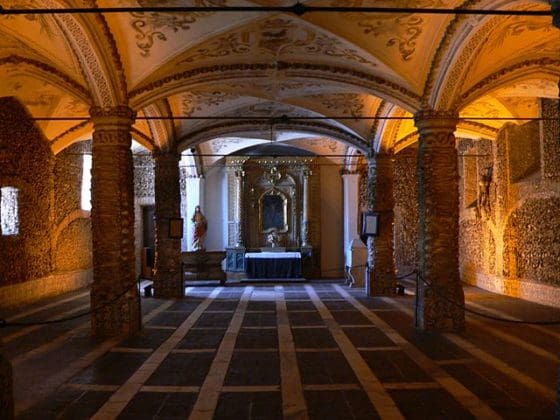The Catholic Church is home to some of the world’s greatest achievements in architecture. Constantly evolving over the past 2000 some years, the Church has produced many of the world greats: The Sistine Chapel, Saint Peter’s Basilica, and the Notre-Dame Cathedral to name just a handful of many. From Romanesque Abbeys, to Gothic Cathedrals or Renaissance Basilicas, there are plenty of design stylings to be had. Over the centuries there have also been some more eccentric designs as well. However, perhaps no church is more of a reminder of our mortality and the macabre than the Chapel of Bones in Évora, Portugal, part of the larger Royal Church of St. Francis.
The Church of St. Francis was founded by three Franciscan monks in the early 13th century. By the 16th century, nearly 50 cemeteries were taking up valuable land around Évora. Not wanting to condemn the souls of those buried there, it was decided to exhume the nearly 5000 corpses to build the Capela dos Osso with inside the Igreja de São Francisco.
60 feet long by 36 food wide, light only can enter through three small openings. It’s white brick ceiling painted with death motifs is held up by eight pillars decorated with carefully arranged bones and skulls, some with graffiti scribblings, held together my cement. On display are two desiccated corpses, one of which is a child. In a small white coffin by the altar lies the bones of the three founding Franciscan brothers of the church.
The purpose of the chapel, a meditation on the transience of life and material things, is made evident with a poem hanging on an old wooden from on one of the pillars, said to be written in the mid 19th century by a parish priest.
“Where are you going in such a hurry, traveler?
Pause… do not advance your travel.
You have no greater concern,
Than this one: that on which you focus your sight.
Recall how many have passed from this world,
Reflect on your similar end.
There is good reason to do so;
If only all did the same.
Ponder, you so influenced by fate,
Among the many concerns of the world,
So little do you reflect on death.
If by chance you glance at this place,
Stop… for the sake of your journey,
The longer you pause, the further on your journey you will be.”
If that wasn’t Memento mori enough, by the altar one can read two Latin phrases:
I die in the light.
The day that I die is better than the day that I was born.
Photo credit: Alonso de Mendoza 1, 2 | JoJan 1, 2 | Nsandre | Dicklyon via Wikimedia | sergei.gussev via Flickr
























That’s disrespectful to the dead, surely?